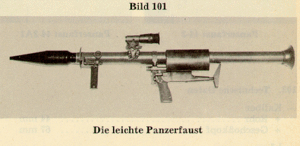| Leichte Panzerfaust 44 mm "Lanze" | |
|---|---|
 PzF 44 | |
| Type | Anti-tank rocket launcher |
| Place of origin | West Germany |
| Service history | |
| In service | 1963–1992 |
| Used by | See Operators |
| Production history | |
| Designed | 1960 |
| Manufacturer | Dynamit Nobel |
| Produced | 1963–1992 |
| Variants | See Variants |
| Specifications | |
| Mass | Unloaded: 7.82 kg (17 lb 4 oz) Loaded: 10.12 kg (22 lb 5 oz) |
| Length | Unloaded: 880 mm (2 ft 11 in) Loaded: 1,180 mm (3 ft 10 in) |
| Cartridge | 44×537mm rocket cartridge |
| Caliber | Barrel: 44 mm (1.7 in) Warhead: 67 mm (2.6 in) |
| Muzzle velocity | At muzzle: 168 m/s (550 ft/s) At max Vo: 210 m/s (690 ft/s) |
| Maximum firing range | ~ 400 m (1,300 ft) |
| Sights | Telescope |
The PzF 44 (abbreviation for Panzerfaust 44 mm, formally also Leichte Panzerfaust,[1] meaning "Light tank-fist", also known as Panzerfaust Lanze (lance) and Panzerfaust 2/Panzerfaust II), was a West German portable recoilless shoulder-fired anti-tank rocket launcher with a barrel-caliber of 44 mm (1.7 in). It was the spiritual successor to the Panzerfaust from World War II and served with the West German Army from the early 1960s to the early 1990s, when it was replaced by the Panzerfaust 3 semi-disposable launcher.
The PzF 44 is called "recoilless" in the sense that it ejects propellant gas rearwards of the chamber upon firing, so called backblast, and not because it truly lacks recoil. Backblast heavily counters recoil but does not fully remove it. The effect of the minimized recoil however is great enough to allow a portable weapon like this to fire large caliber warheads without causing trauma to the user.
- ^ Kurzbeschreibung der Leichten Panzerfaust (Panzerfaust 44 mm), Modell 44-1A1 (in German). West Germany. 1963 – via YouTube.
{{cite book}}: CS1 maint: location missing publisher (link)